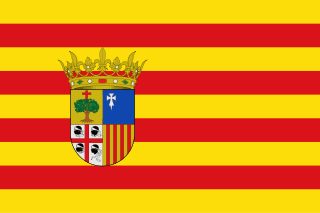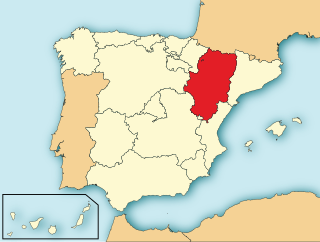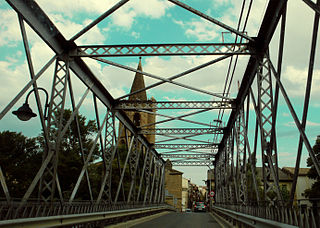
Aragon is an autonomous community in Spain, coextensive with the medieval Kingdom of Aragon. Located in northeastern Spain, the Aragonese autonomous community comprises three provinces : Huesca, Zaragoza, and Teruel. Its capital is Zaragoza. The current Statute of Autonomy declares Aragon a historic nationality of Spain.

Sesa is a municipality located in the Hoya de Huesca comarca, province of Huesca, Aragon, Spain. According to the 2010 census the municipality has a population of 225 inhabitants. Its postal code is 22110.

Guadalajara is a province of central/north-central Spain, in the northern part of the autonomous community of Castilla–La Mancha. As of 2013 it had a population of 257,723 people. The population of the province has grown in the last 10 years.

The Kingdom of Aragon was a medieval and early modern kingdom on the Iberian Peninsula, corresponding to the modern-day autonomous community of Aragon, in Spain. It should not be confused with the larger Crown of Aragon, that also included other territories — the Principality of Catalonia, the Kingdom of Valencia, the Kingdom of Majorca, and other possessions that are now part of France, Italy, and Greece — that were also under the rule of the King of Aragon, but were administered separately from the Kingdom of Aragon.

The Kingdom of Castile was a large and powerful state located on the Iberian Peninsula during the Middle Ages. Its name comes from the host of castles constructed in the region. It began in the 9th century as the County of Castile, an eastern frontier lordship of the Kingdom of León. During the 10th century its counts increased their autonomy, but it was not until 1065 that it was separated from León and became a kingdom in its own right. Between 1072 and 1157 it was again united with León, and after 1230 this union became permanent. Throughout this period the Castilian kings made extensive conquests in southern Iberia at the expense of the Islamic principalities. The Kingdoms of Castile and of León, with their southern acquisitions, came to be known collectively as the Crown of Castile, a term that also came to encompass overseas expansion.

The Crown of Aragon was a composite monarchy, also nowadays referred to as a confederation of individual polities or kingdoms ruled by one king, with a personal and dynastic union of the Kingdom of Aragon and the County of Barcelona. At the height of its power in the 14th and 15th centuries, the Crown of Aragon was a thalassocracy controlling a large portion of present-day eastern Spain, parts of what is now southern France, and a Mediterranean "empire" which included the Balearic Islands, Sicily, Corsica, Sardinia, Malta, Southern Italy and parts of Greece. The component realms of the Crown were not united politically except at the level of the king, who ruled over each autonomous polity according to its own laws, raising funds under each tax structure, dealing separately with each Corts or Cortes. Put in contemporary terms, it has sometimes been considered that the different lands of the Crown of Aragon functioned more as a confederation than as a single kingdom. In this sense, the larger Crown of Aragon must not be confused with one of its constituent parts, the Kingdom of Aragon, from which it takes its name.

Segorbe is a municipality in the mountainous coastal province of Castelló, autonomous community of Valencia, Spain. The former Palace of the Dukes of Medinaceli now houses the city's mayor. Segorbe's bull-running week in September attracts 200,000 visitors each year. The name in Valencian is Sogorb, but the local language is Spanish, not Valencian.

The Principality of Catalonia was a medieval and early modern political entity in the northeastern Iberian Peninsula. During most of its history it was in dynastic union with the Kingdom of Aragon, constituting together the Crown of Aragon. Between the 13th and the 18th centuries, it was bordered by the Kingdom of Aragon to the west, the Kingdom of Valencia to the south, the Kingdom of France and the feudal lordship of Andorra to the north and by the Mediterranean sea to the east. The term Principality of Catalonia remained in use until the Second Spanish Republic, when its use declined because of its historical relation to the monarchy. Today, the term Principat (Principality) is used primarily to refer to the autonomous community of Catalonia in Spain, as distinct from the other Catalan Countries. and usually including the historical region of Roussillon in southern France.
Tafalla is a town and municipality located in the province and autonomous community of Navarre, northern Spain. The Postal code is 31300.

The Crown of Castile was a medieval state in the Iberian Peninsula that formed in 1230 as a result of the third and definitive union of the crowns and, some decades later, the parliaments of the kingdoms of Castile and León upon the accession of the then Castilian king, Ferdinand III, to the vacant Leonese throne. It continued to exist as a separate entity after the personal union in 1469 of the crowns of Castile and Aragon with the marriage of the Catholic Monarchs up to the promulgation of the Nueva Planta decrees by Philip V in 1715.

Sangüesa is a city in Navarre, Spain, 44.5 kilometers from Pamplona. It lies close to the River Aragon and in 2007 had a population of 5,128. It is located on the Way of Saint James. It has been an important stopping point for pilgrims since the Middle Ages and has preserved its medieval character.

Peracense is a town in the province of Teruel, Aragon, on the north-east of Spain. It is located 51 kilometres from Teruel, the capital province.

Ademuz is a municipality in the comarca of Rincón de Ademuz in the Valencian Community, Spain. The name in Valencian is Ademús, but the local language is Spanish, not Valencian.

Monzón is a small city and municipality in the autonomous community of Aragon, Spain. Its population was 17,176 as of 2014. It is in the northeast and adjoins the rivers Cinca and Sosa.
Santa Bárbara Castle is a fortification in the center of Alicante, Spain. It stands on Mount Benacantil.

Tibi is a municipality in the comarca of Alcoià, Alicante, Valencia, Spain. The name of this municipality comes from Latin and it means "for you". This territory was populated with 1,564 people in the year 2018.

The Atalaya Castle is a castle in Villena, province of Alicante, southern Spain. Located over a spur of the Sierra de la Villa, in the north-western part of the province of Alicante, it commands the former frontier between Castile and Kingdom of Aragon.

The Castle of Xavier is located on a hill in the town of Javier, 52 km east of Pamplona and 7 km east of Sangüesa. Built in the 10th century, this castle was the birthplace and childhood home of Saint Francis Xavier, son of the Lords of Xavier, hence his surname. The town of Javier belonged to the Kingdom of Navarre which was always its own kingdom, never belonging to France.

Sierra Menera is a 31 km (19 mi) long mountain range in the southwestern end of the Iberian System.

The coat of arms of Castile was the heraldic emblem of its monarchs. Historian Michel Pastoureau says that the original purpose ofheraldic emblems and seals was to facilitate the exercise of power and the identification of the ruler, due to they offered for achieving these aims. These symbols were associated with the kingdom, and eventually also represented the intangible nature of the national sentiment or sense of belonging to a territory.


















